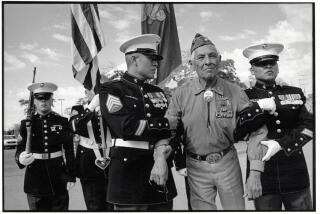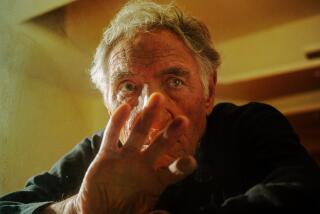Coy Watson Jr. dies at 96; one of nine silent-era sibling actors
- Share via
Coy Watson Jr., who was the eldest in a family of nine child actors and whose book “The Keystone Kid,” recounted a silent-film career that began in 1913, has died. He was 96.
FOR THE RECORD:
Coy Watson Jr. obituary: The obituary of former child actor Coy Watson Jr. in Tuesday’s Section A said Watson’s brothers played Jimmy Stewart’s sons in the 1939 film “Mr. Smith Goes to Washington.” The Watson brothers were cast as the Hopper boys, sons of the governor who appointed Smith to the Senate. —
Watson, who became a news photographer and television cameraman, died Saturday of complications from stomach cancer in Alpine, Calif., where he lived, his nephew Daniel Watson said.
By the late 1930s, Watson and his eight siblings had appeared in more than 1,000 movies. Their careers were almost an accident of geography because their family home was in Edendale, an early movie-studio enclave north of the Echo Park lake.
Mack Sennett Studios was nearby and three other studios filled out the movie colony. When Selig studios came calling, Watson -- who was born Nov. 16, 1912 -- was 9 months old.
The studio needed a baby for a short film, “The Price of Silence,” and promised to pay the infant $5 for a day’s work. Because the Edendale neighborhood was not yet wired for electricity, his scene was shot on a bedroom set built to take advantage of the sun.
James Caughey “Coy” Watson Jr. would go on to appear in so many of Sennett’s Keystone Cops comedies that he earned a nickname: “the Keystone Kid.”
By the time he was 18, Watson had made about 60 motion pictures, including “The Hunchback of Notre Dame” (1923) with Lon Chaney, “Buttons” (1927) with Jackie Coogan and “Show People” (1928) with Marion Davies.
His father, Coy Watson Sr., broke horses for cowboy stars and created special effects, notably the flying carpet Douglas Fairbanks used in the 1924 film “The Thief of Bagdad.” Eventually, Watson’s father gave up his career to manage those of his six sons and three daughters.
When a director would say, “I need a child for a movie. Do you have one?” the senior Watson was said to respond: “What size and what sex?”
In “The Keystone Kid,” the junior Watson wrote of a childhood spent watching cowboys congregate on a street corner, hoping to get work. He recalled actress Gloria Swanson stopping in at the family home to iron her skirt between scenes and building a treehouse with his best friend on the Sennett lot.
“Acting to our family was not a business,” Watson told the San Diego Union-Tribune in 2002. “It was our life. We never knew anything but the movies.”
Watson’s mother, Golda, washed and ironed actors’ costumes. His brother Delmar was Shirley Temple’s goat-herding friend in “Heidi” (1937). Delmar and three other Watsons played sons of Jimmy Stewart in “Mr. Smith Goes to Washington” (1939). His brother Bobs, who had an MGM contract, was the endearing Pee Wee in “Boys Town” (1938) with Spencer Tracy.
After talkies came into vogue, Watson had parts in several more films. But the boy who made 13 movies in 1927 no longer enjoyed the process.
The advent of sound in films “scared the dickens out of everybody,” Watson said in the 2002 Union-Tribune interview. “We used to have fun making pictures. But when sound came in you couldn’t drop a pin.”
He turned to another family business -- photography -- that he first discovered in a class held by the Boy Scouts.
His grandfather, James Watson, shot pictures of Buffalo Bill riding up Broadway in 1904. His uncle, George Watson, was hired as The Times’ first full-time news photographer in 1917 and later founded Acme News Pictures, a forerunner of United Press Photos and training ground for the Watson boys.
In junior high, Coy built a darkroom at home and “made a few nickels and dimes” taking photographs of his classmates, he later said. After graduating from high school, he joined the Pacific and Atlantic photo news service.
In 1932, he covered the Summer Olympics in Los Angeles for Acme and photographed future president Franklin D. Roosevelt’s visit to the city the same year.
In the ensuing years, Watson took pictures for a number of newspapers that have long since vanished. His photographs also appeared in The Times.
During World War II, he was one of four Watson brothers to serve as a Coast Guard cameraman, running a Coast Guard photography unit in San Diego.
All six brothers worked as press, newsreel or television photographers after the war. Watson became a cameraman for KTLA Channel 5 and for CBS on the West Coast. He also spent time at ABC and KCRA-TV in Sacramento, according to a family biography.
With Erskine Johnson, an actor who wrote a Hollywood column for the Daily News, Watson made “Hollywood Reel.” The television program, filmed in 1949 and 1950, featured dozens of interviews with celebrities.
Of a life spent on both sides of the camera, Watson once said, “The motion picture business was something that if you liked it, it was your life. And that’s the way it was with me.”
His brother Delmar, who founded the Watson Family Photographic Archive that oversees the family’s trove of photos, died in October at 82.
Three of the Watson siblings survive: Louise Roberts, 89, Billy Watson, 85, and Garry Watson, 80.
Coy Watson Jr. is also survived by his wife, Willie; a daughter, Pattie Watson Price of Alpine; a son, James Caughey “Jim” Watson III of Perth, Australia; three grandchildren and four great-grandchildren.
Services will be private.
More to Read
Start your day right
Sign up for Essential California for the L.A. Times biggest news, features and recommendations in your inbox six days a week.
You may occasionally receive promotional content from the Los Angeles Times.








